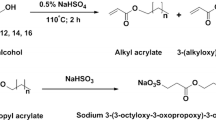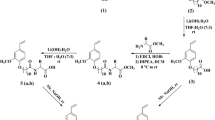Abstract
Sodium dodecyl sulfate (SDS) was modified by a aldol reaction with formaldehyde. The molar ratios of SDS to formaldehyde were 1 : 1, 1 : 2, 1 : 3, and 1 : 4, the obtained products were named as HSDS(1 : 1), HSDS(1 : 2), HSDS(1 : 3), HSDS(1 : 4). The effects of reaction conditions (molar ratio) on surface properties were studied, including surface tension, foaming ability, high temperature resistance, methanol resistance and salt resistance. The research results obtained show that the best foaming concentration of the products with different molar ratio HSDS(1 : 1) to HSDS(1 : 4) is 0.4%. When the concentration of the surfactant solution is 0.4%, the half life time of the HSDS(1 : 1) reaches 7.71 min. Temperature, methanol and inorganic salts have great influence on the foaming ability of the products with different reaction conditions HSDS(1 : 1) to HSDS(1 : 4). In the presence of methanol and inorganic salts, the foam will disappear at an accelerated rate. But when the methanol concentration is less than 20%, the foam formed by SDS and HSDS(1 : 1) to HSDS(1 : 4) is HSDS(1 : 2) > SDS > HSDS(1 : 3) > HSDS(1 : 1) > HSDS(1 : 4). When the salinity reaches 200 g/L, the product with molar ratio of 1 : 4 (HSDS(1 : 4)) can still produce 350 mL foam, indicating that it has a certain salt resistance. When the concentration was 0.1 g/L, the emulsifying ability with different molar ratios is HSDS(1 : 3) > HSDS(1 : 4) > HSDS(1 : 2) > SDS > HSDS(1 : 1); when the concentration was 0.2 g/L, the emulsifying ability was HSDS(1 : 4) > HSDS(1 : 3) > HSDS(1 : 2) > SDS > HSDS(1 : 1). The emulsifying ability of SDS and the products obtained at different molar ratios is general, and the emulsion will stratify after 30 min, followed by foam, crude oil and water from top to bottom.














Similar content being viewed by others
REFERENCES
J. C. Ding, Nat. Gas Geosci. 28, 127 (2017).
S. Zhang, X. Bai, L. Fan, et al., Nat. Gas Industry 25, 106 (2005).
J. Yang, V. Jovancicevic, and S. Ramachandran, Colloids Surf. 309, 177 (2007).
M. L. Gao, J. Zhang, Q. N. Liu, et al., CR Chim. 22, 355 (2019).
J. Eastoe, S. Nave, A. Downer, et al., Langmuir 16, 4511 (2000).
A. J. Wilson, Foams, Physics, Chemistry and Structure (Springer, London, 1989), p. 167.
B. M. Folmer and B. Krongberg, Langmuir 16, 5987 (2000).
K. Lunkenheimer and K. Malysa, J. Surfact. Deterg. 6, 69 (2003).
M. L. Gao, F. Q. Lei, Q. N. Liu, et al., Russ. J. Phys. Chem. A 93 (13), 2735 (2019).
E. Kuliszwska and L. Brecker, J. Surfact. Deterg. 17, 951 (2014).
B. M. Folmer and B. Kronberg, Langmuir 16, 5987 (2000).
K. Lunkenheimer and K. Malysa, J. Surfact. Deterg. 6, 69 (2003).
C. F. Xu, X. X. Sun, and X. Guo, Therm. Power Gener. 6, 34 (2005).
Diao Jingren, J. Magn. Mater. Dev. 12, 49 (2012).
G. Chen, Y. Bai, Q. N. Liu, et al., J. Surfactants Deterg. 22, 691 (2019).
L. S. Wang, Y. B. Cao, T. T. Yu, Q. F. Cao, Y. H. Cao, and X. Q. An, ODPT 29, 75 (2007).
A. Nabel, F. Ahmed, M. Farargy, et al., J. Surfact. Deterg., 433 (2012).
Y. L. Yan, Y. Wang, C. Shan, and X. F. Gu, Chin. Surfact. Deterg. Cosmet. 43, 303 (2013).
B. S. Gardiner, B. Z. Dlugogorski, and G. J. Jameson, J. Phys.: Condens. Matter 11, 5437 (1999).
S. Maaref and S. Ayatollahi, J. Dispers. Sci. Technol. 39, 01932691 (2017);
J. Dispers. Sci. Technol. 39, 1386569 (2017).
Funding
This work was financially supported by the grants from National Science Foundation of China (41202214, 51774184), Shaanxi Provincial Key Research and Development Program (2019ZDLGY06-03), and Postgraduate Innovation Fund Project of Xi’an Shiyou University (YCS19111009). And we thank the work of Modern Analysis and Testing Center of Xi’an Shiyou University.
Author information
Authors and Affiliations
Corresponding author
Rights and permissions
About this article
Cite this article
Minlan Gao, Bai, Y., Dong, S. et al. Synthesis and Properties of Sodium Dodecyl Sulfate-Derived Multifunctional Surfactants. Russ. J. Phys. Chem. 94, 2155–2167 (2020). https://doi.org/10.1134/S0036024420100106
Received:
Revised:
Accepted:
Published:
Issue Date:
DOI: https://doi.org/10.1134/S0036024420100106




